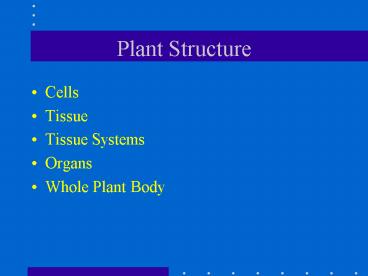Plant Structure - PowerPoint PPT Presentation
1 / 51
Title:
Plant Structure
Description:
Flowers. Reproductive Organs, usually dependent on pollination naturally by insects. ... Sepals Calyx (collective) green leaf-like structures, encase flower in bud. ... – PowerPoint PPT presentation
Number of Views:141
Avg rating:3.0/5.0
Title: Plant Structure
1
Plant Structure
- Cells
- Tissue
- Tissue Systems
- Organs
- Whole Plant Body
2
Plant Cells
3
Plant Cell Components
- Nucleus
- Protoplasm
- Mitochondria
- Golgi Bodies
- Endoplasmic reticulum
- Vacuoles
- Chloroplasts
- Cell Wall
4
Plant Cell
5
Plant Tissue
- Meristematic Tissue
- Permanent Tissue
- Simple Tissue
- Complex Tissue
6
Meristematic Tissue
- Apical Meristems - main axis
- Vascular Cambium - continuous around plant
- Cork Cambium - continuous in cortex
- Lateral Meristems - new lateral shoots
7
Apical Meristematic Tissue
8
Permanent Simple Tissue
- Parenchyma
- Collenchyma
- Sclerenchyma
9
Parenchyma
- Parenchyma is the most common ground tissue
(simple thin walled cells). - Cortex
- Pith
- Mesophyll (leaves, the pulp of fruits)
- Endosperm (seeds).
- Parenchyma cells are still meristematic, which
means that they are capable of cell division even
after maturation.
10
Collenchyma
- Collenchyma tissue is composed of elongated cells
with unevenly thickened walls. They provide
structural support, particularly in growing
shoots and leaves. Collenchyma tissue composes,
for example, the resilient strands in stalks of
celery.
11
Sclerenchyma
- Sclerenchyma is a supporting tissue. Two groups
of sclerenchyma cells exist fibres and
sclereids. Their walls consist of cellulose and
lignin. Sclerenchyma fibers are of great
economical importance, since they constitute the
source material for many fabrics (flax, hemp,
jute,). Sclerid cells in pears.
12
Permanent Complex Tissue
- Xylem - Water and mineral conducting tissue,
non-living - Tracheids, Vessels and Fibers
- Phloem - Conducts sugars to stems and roots from
leaves - Sieve Elements and Companion Cells
13
Xylem
14
Vascular System-Woody Dicot
15
X-Section - Woody Dicot
16
Pine Stem X-Section
17
Pine Stem X-Section
18
Pine-Cutaway Section
19
Vascular System - Monocot
20
Vascular Bundle
21
Plant Structure
- Vascular System
- Cortex
- Epidermis
22
Vascular System
- Xylem
- Phloem
23
Cortex
- Equal to Frame and Insulation of a House
- Cork Cambium formation of cork via
suberization - Lenticels- Rough and ruptured areas on stem, use
for gas exchange
24
Epidermis
- Single layer of cells enveloping plant.
- Surface of rose petals
- Root hair cells
- Stomata
25
Root Hair Cell
26
Stomata
- Openings on the undersides of leaves made up of
two guard cells. Involved in the process of
transpiration.
27
Stomata
28
Plant Stems
- Central Axis of plant which supports vital
organs. - Above Ground
- Underground
29
Above Ground Stems
- Support
- leaves,
- buds,
- flowers
30
Roots
- Tap
- Fibrous
- Fleshy
- Tuberous
31
Root Functions
- Anchorage
- Storage
- Water and nutrient uptake
32
Above Ground Modified Stems
- Runners, Stolons
- Spurs
- Suckers
- Water Sprouts (epicormic)
33
Underground Stems
- Bulbs
- Corms
- Rhizomes
- Tubers
34
Tunicate Bulbs
35
Scaly Bulb
36
Corm
37
Rhizome
38
Tulip Grower
39
Field of Tulips
40
Leaves
- Primary Purpose Photosynthesis
- Consists of Blade and Petiole and Stipule
41
Leaf Blade Cross-Section
42
(No Transcript)
43
Flowers
- Reproductive Organs, usually dependent on
pollination naturally by insects. - Sight
- Odor
44
Flowers
45
Flower Types
- Complete
- Incomplete
- Perfect
- Staminate
- Pistillate
46
Flower Structure
47
Flower Parts
- Pistil (Female)
- Stigma surface for pollen
- Style supports stigma
- Ovary - fertilization
48
Flower Parts
- Stamens (Male)
- Anthers pollen
- Filament supports anther
49
Flower parts
- Petals Corolla (collective) most obvious parts
of flower - Sepals Calyx (collective) green leaf-like
structures, encase flower in bud. - Receptacle supports ovary and rest of floral
structures
50
Fruit
- Mature Ovary
- simple-derived from a single ovary
- aggregate-many pistils on a common receptacle
- multiple-many closely clustered flowers
51
Seed
- Mature Ovule
- Parts
- Seed Coat
- Endosperm
- Embryo































